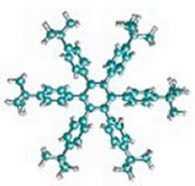Atom Hauler
Specially designed molecules can pick up and move around bunches of atoms on a surface.
Share this:
- Share via email (Opens in new window) Email
- Click to share on Facebook (Opens in new window) Facebook
- Click to share on X (Opens in new window) X
- Click to share on Pinterest (Opens in new window) Pinterest
- Click to share on Reddit (Opens in new window) Reddit
- Share to Google Classroom (Opens in new window) Google Classroom
- Click to print (Opens in new window) Print
By Emily Sohn
Atoms are everywhere, but you’d never know it. Even though these tiny building blocks of matter make up everything—from chairs to air—they’re far too tiny to see with your own eyes.
When scientists want to study atoms one at a time, however, they can use special, highly sensitive microscopes to see them. Using these tools, called scanning tunneling microscopes (STMs), researchers can also move individual atoms around.
Now, researchers in France and Germany have taken the technology one step further. They have found a way to gather up and move around atoms in bunches. Their work may help them eventually make and operate tiny, nanoscale machines.
 |
|
A specially designed molecule, seen as a colored tower, gobbles up dotlike atoms of copper that stick up from a copper surface (left to right). The molecule can then drop off its cargo at any other location. |
| Gross et al./Nature Materials |
The key part of a scanning tunneling microscope is an extremely sharp needle that rides over the surface being examined. This sharp tip can even nudge a single atom from one place to another. But maneuvering more than one atom at a time is a difficult juggling act.
To make the task easier, the researchers created a new, six-legged molecule. They called it hexa-t-butyl-hexaphenylbenzene (HB-HBP). The molecule is shaped like a hexagon (having six sides) and contains rings of carbon atoms. Six tripodlike feet support the structure. Like a minuscule vacuum cleaner, it can easily slide over a copper surface, sucking up loose copper atoms.
 |
|
This diagram shows an HB-HBP molecule as it would appear if its “feet” were spread out sideways. A ring of six carbon atoms forms the molecule’s center. |
| Gross et al./Nature Materials |
Experiments performed at very low temperatures and in practically airless conditions showed that an STM tip can move an HB-HBP molecule that holds as many as five copper atoms that the molecule has picked up. Scientists can then use the STM tip to lift the carrier molecule, leaving the clump of atoms behind.
The development is a major step toward making molecule-sized machines, scientists say. Someday, tiny sweepers might gather atoms together to form wires. Or they might pile atoms into regularly spaced mounds that, together, affect light or magnetic fields in useful ways.—E. Sohn
Going Deeper:
Weiss, Peter. 2005. Atom hauler: Molecular rig snags multi-atom loads. Science News 168(Nov. 26):339-340. Available at http://www.sciencenews.org/articles/20051126/fob2.asp .
You can learn more about the scanning tunneling microscope and seeing atoms one at a time at www.lbl.gov/wonder/salmeron.html (Lawrence Berkeley National Laboratory).
Sohn, Emily. 2004. The incredible shrunken kids. Science News for Kids (June 9). Available at http://www.sciencenewsforkids.org/articles/20040609/Feature1.asp .







